Rock Art Intermission #1 - Cup-and-Ring Markings at Ormaig
I deliberated on whether I should dive straight into the Bronze Age linear cemetery at Kilmartin or not, and decided against it. I thought I'd pause instead to introduce you to the prehistoric rock art of the area. Some of you - living in Northumbria and Wales in particular - will be familiar with the cup-markings and cup-and-ring markings which are a characteristic feature of the 'highland' zone (i.e the north and west, according to Sir Cyril Fox) of Britain . Others will not have a clue what I'm talking about.
I'm going to deal with these sites in my reverse order of preference. Ormaig was new to me - I'd visited the rock art at Kilmichael Glassery and Achnabreck previously, but Cairnbaan was still on my list and I hadn't even heard of Ormaig until I bought The Footsteps of Kings, which described the Ormaig markings as:-
'one of the best in Europe.'
Wow. That's quite a reputation to live up to.
Many of the rock art sites are doing much better for themselves these days. A few decades ago, some of our best prehistoric rock art was buried in the depths of dense coniferous plantations, but in recent years the Forestry Commission has gone to great efforts to create much more sympathetic settings where these monuments can be accessed by visitors and where they can be appreciated, too.
The road to Ormaig is not an easy one. We walked from Kilmartin, a distance of around 4 and a half miles which follows the old Poltalloch estate road over much of its length. Unfortunately, the last few winters had brought down a lot of trees, and there's a 300m stretch which requires a wee bit of negotiating, and I think it's safe to say that it's only the most intrepid or idiotic explorers who will persist in their quest (I still bear the bruises...):-
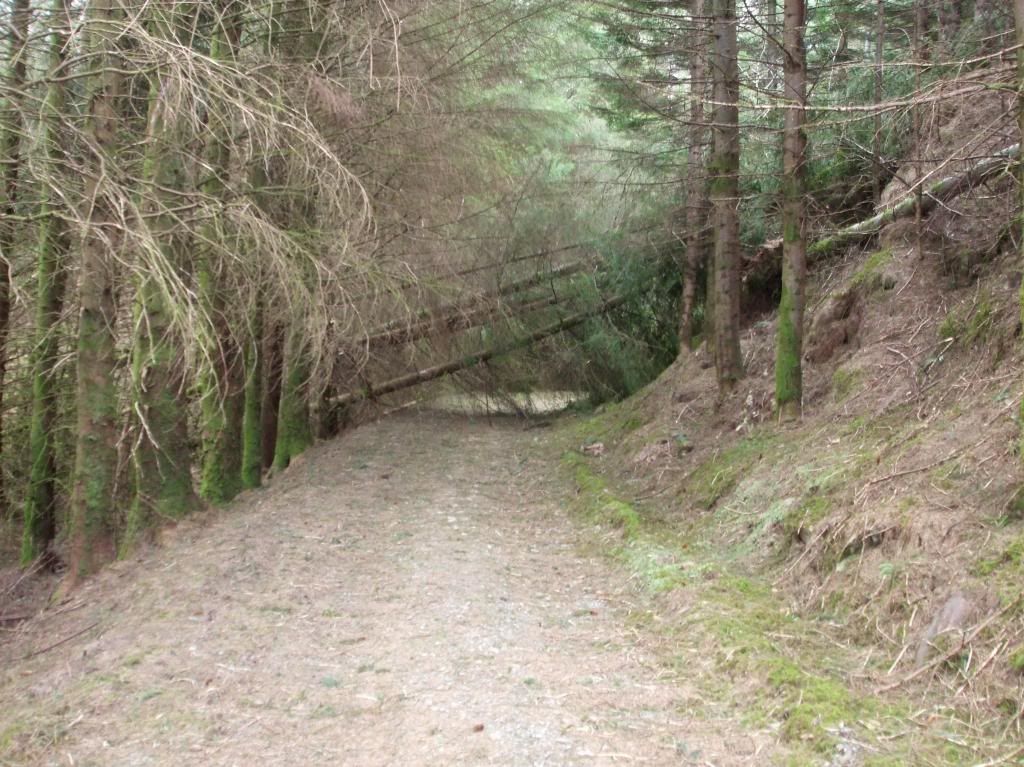
From a distance, the site is far from prepossessing:-
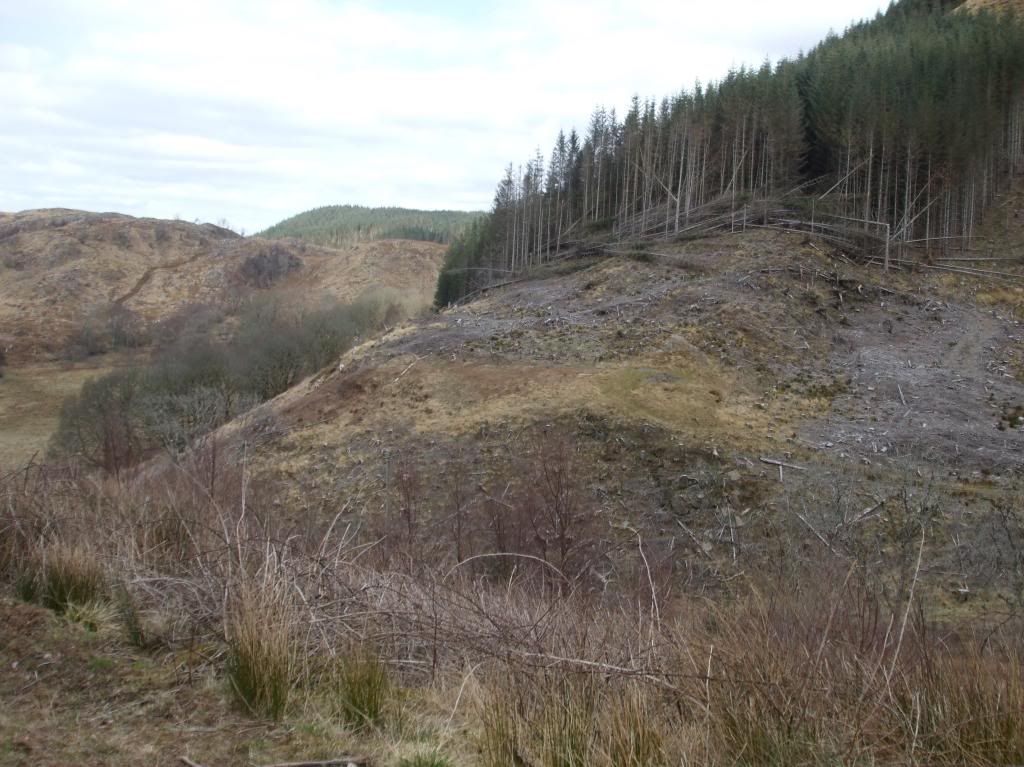
Prehistoric rock art tends to be found on sheets of outcrop which look out over natural amphitheatres, but which may have fairly closed-in views in other directions. Ormaig demonstrates this perfectly, as this view from the outcrop itself shows clearly:-
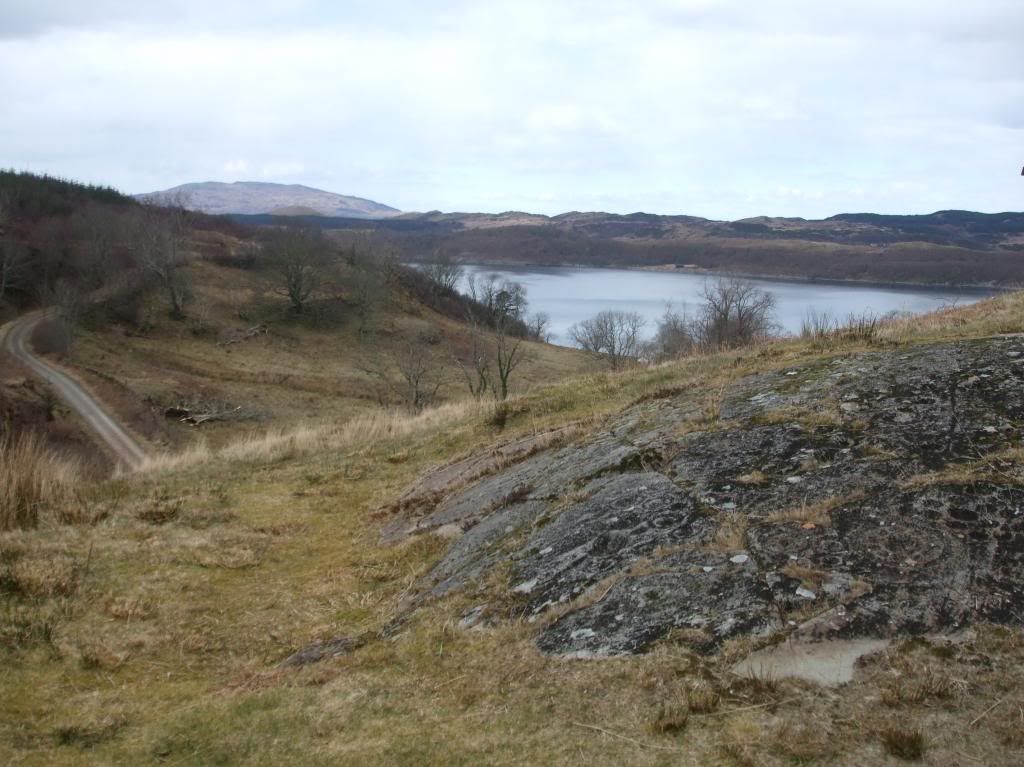
And yes, that is the rock art that you can see on the outcrop. There are seven different areas of rock art at Ormaig, named variously Exposures 1-7 (though Exposures may also be subdivided into component groups). Exposure 3 was good:-
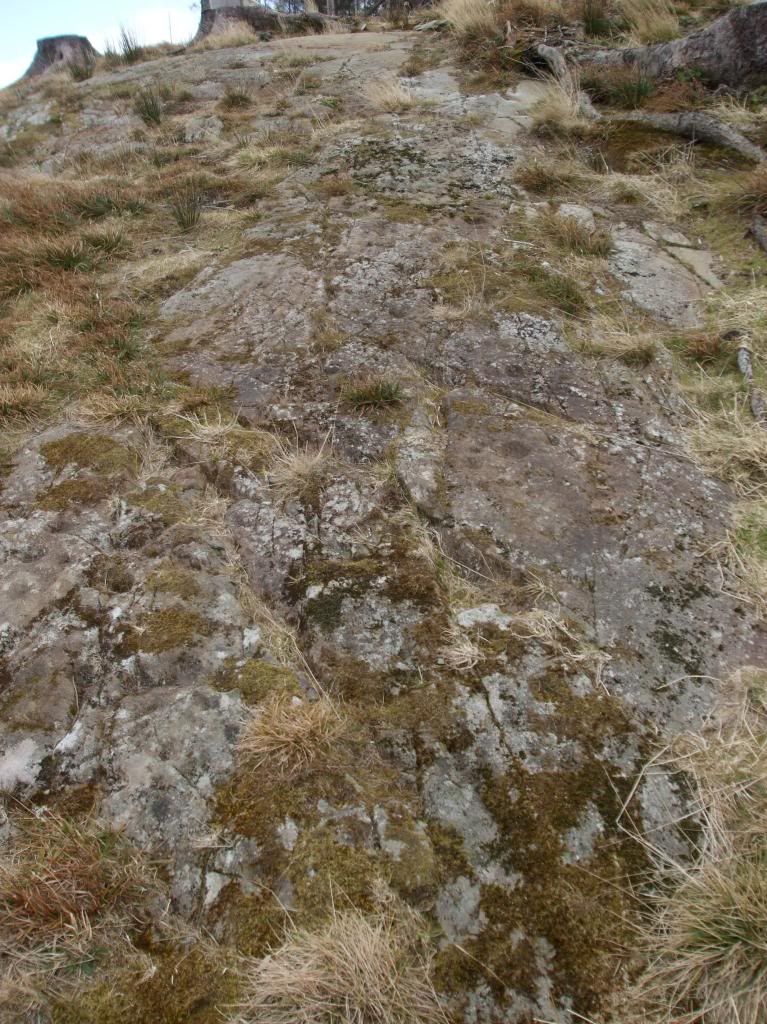
But while this certainly won the award for the largest number of cupmarks and associated features, it certainly didn't win the prize for impact (and I'm sure many of you will be scratching your heads as you look at it and wonder what all the fuss is about!!)
Let's got to Exposure 1 now, which is a whole different kettle of fish:-
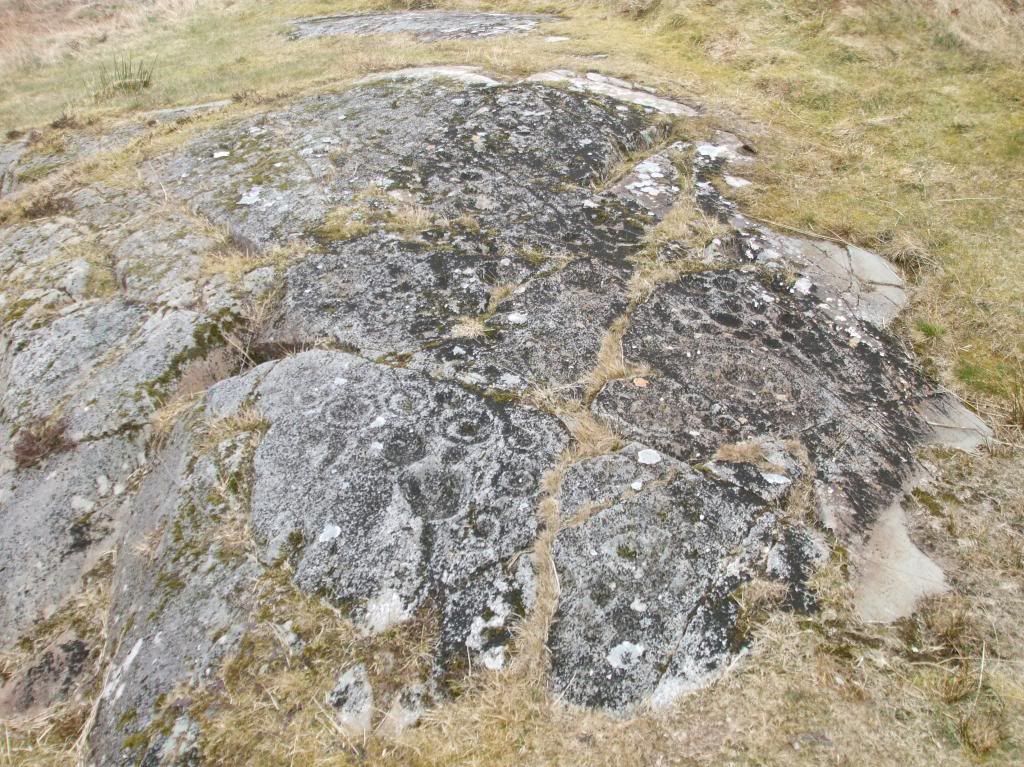
And a close-up of Exposure 1 (South), showing the full range of markings at this site. There's single cups, cups and single rings, cups and multiple rings, cups linked with gutters, and weird multiple cups with rings:-
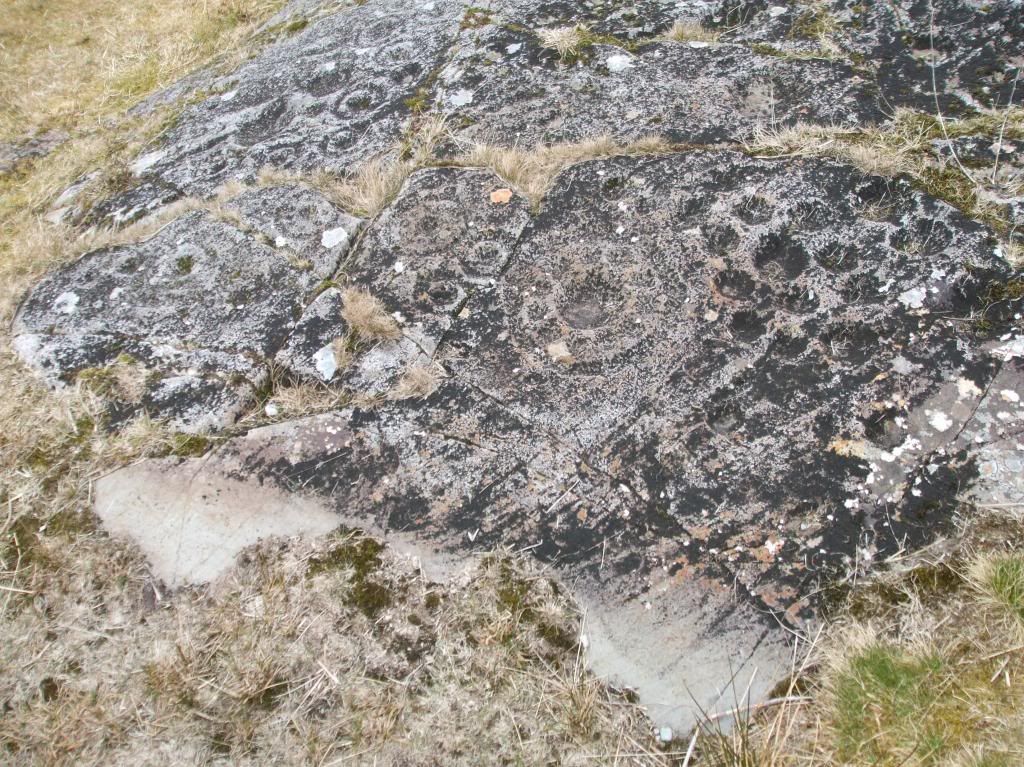
So what's it all about? Well, as yet no-one knows. And no-one's ever likely to know, either, because these things exist virtually in isolation and no-one has ever stripped the topsoil of the neighbouring square kilometre of ground to see what else is kicking around. Even the topic of 'when' is hotly debated. A Bronze Age date was assumed for years, for reasons which will soon be made apparent, but now a Neolithic origin is being postulated because of similarities in this kind of outdoor rock art with the decorative motifs on Neolithic passage graves like Knowth and Newgrange.
I shall offer my two cents' worth on the subject before I leave the topic of Kilmartin, but in the meantime I shall leave you with a picture of one of the more humble pieces of rock art amongst the Ormaig 'portfolio- - I can't quite figure out whether it's Exposure 4, or Exposure 5, because when I'm mucking about on my holidays, my photo record tends to be non-existent!!

With its combinations of simple cups, cups with single rings and connecting gutters, this is a much more typical example of the kind of cup-and-ring marked rock which can be found throughout Scotland. Why the mid-Argyll stuff is quite so strange and fancy is a mystery, and a topic which will I'm sure be hotly debated by academic archaeologists for a long time to come!
I'm going to deal with these sites in my reverse order of preference. Ormaig was new to me - I'd visited the rock art at Kilmichael Glassery and Achnabreck previously, but Cairnbaan was still on my list and I hadn't even heard of Ormaig until I bought The Footsteps of Kings, which described the Ormaig markings as:-
'one of the best in Europe.'
Wow. That's quite a reputation to live up to.
Many of the rock art sites are doing much better for themselves these days. A few decades ago, some of our best prehistoric rock art was buried in the depths of dense coniferous plantations, but in recent years the Forestry Commission has gone to great efforts to create much more sympathetic settings where these monuments can be accessed by visitors and where they can be appreciated, too.
The road to Ormaig is not an easy one. We walked from Kilmartin, a distance of around 4 and a half miles which follows the old Poltalloch estate road over much of its length. Unfortunately, the last few winters had brought down a lot of trees, and there's a 300m stretch which requires a wee bit of negotiating, and I think it's safe to say that it's only the most intrepid or idiotic explorers who will persist in their quest (I still bear the bruises...):-

From a distance, the site is far from prepossessing:-

Prehistoric rock art tends to be found on sheets of outcrop which look out over natural amphitheatres, but which may have fairly closed-in views in other directions. Ormaig demonstrates this perfectly, as this view from the outcrop itself shows clearly:-

And yes, that is the rock art that you can see on the outcrop. There are seven different areas of rock art at Ormaig, named variously Exposures 1-7 (though Exposures may also be subdivided into component groups). Exposure 3 was good:-

But while this certainly won the award for the largest number of cupmarks and associated features, it certainly didn't win the prize for impact (and I'm sure many of you will be scratching your heads as you look at it and wonder what all the fuss is about!!)
Let's got to Exposure 1 now, which is a whole different kettle of fish:-

And a close-up of Exposure 1 (South), showing the full range of markings at this site. There's single cups, cups and single rings, cups and multiple rings, cups linked with gutters, and weird multiple cups with rings:-

So what's it all about? Well, as yet no-one knows. And no-one's ever likely to know, either, because these things exist virtually in isolation and no-one has ever stripped the topsoil of the neighbouring square kilometre of ground to see what else is kicking around. Even the topic of 'when' is hotly debated. A Bronze Age date was assumed for years, for reasons which will soon be made apparent, but now a Neolithic origin is being postulated because of similarities in this kind of outdoor rock art with the decorative motifs on Neolithic passage graves like Knowth and Newgrange.
I shall offer my two cents' worth on the subject before I leave the topic of Kilmartin, but in the meantime I shall leave you with a picture of one of the more humble pieces of rock art amongst the Ormaig 'portfolio- - I can't quite figure out whether it's Exposure 4, or Exposure 5, because when I'm mucking about on my holidays, my photo record tends to be non-existent!!

With its combinations of simple cups, cups with single rings and connecting gutters, this is a much more typical example of the kind of cup-and-ring marked rock which can be found throughout Scotland. Why the mid-Argyll stuff is quite so strange and fancy is a mystery, and a topic which will I'm sure be hotly debated by academic archaeologists for a long time to come!